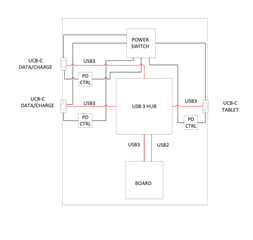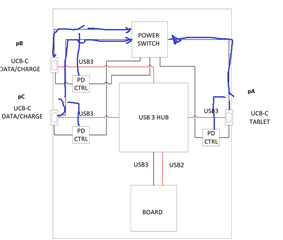Other Parts Discussed in Thread: TUSB8043A, TUSB8044A, , TMUXHS4212, TUSB1042I, TPS25751
Tool/software:
Hi,
I’m working on a project that requires a 4 port USB3 hub. The upstream and two of the downstream ports shall be USB-C ports. The others downstream ports will be used for communication with on board devices. The upstream USB-C port will be connected to a tablet. The two USB-C downstream ports we want to be used as a data or charging port interchangeably, meaning we want to connect a USB-C charger on one and USB-C flash drive on the other. The charger will charge the tablet while we download data from the tablet on the other port. For USB 3 hub I think to use TUSB8043a OR TUSB8044A. PD controller probably TPS25750. USB MUX TMUXHS4212 or TUSB1042I.
Can you recommend how to implement the power switching circuit that will be sitting between the two USB-C DFP and the USB-C UFP to be able to charge the tablet or sink power from it.
Here is a diagram of the device.




